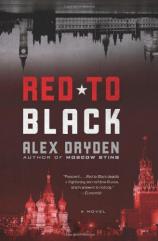Red to Black
Review
Red to Black
We are informed that Alex Dryden, the author of RED TO BLACK, is
a pseudonym for a British journalist and writer who has watched and
chronicled the transformations of the Russian Empire for over two
decades. While marketed as a novel, it is more a historical
chronicle coated with a veneer of fiction. Topically (and, in some
ways, stylistically), it puts one in the mind of some of the works
of Nick Tosches, though without the denseness that occasionally
weighs down his efforts. The end result, however, is a
haunting treatise on the state of espionage as is practiced in the
21st century in a game that is still, if truth be told, in early
innings.
RED TO BLACK, published in 2008 in Britain, follows an MI6 agent
named Finn, who in the late 20th century is initially stationed in
Moscow as a trade secretary. The Soviet government knows that Finn
is a spy; he knows this, and the government is aware that he does.
Finn, however, has a great deal of fun shining their
representatives on, as well as his own superiors. His story is told
primarily through the eyes of “Rabbit,” his pet name
for Anna, who is the youngest female colonel in the history of the
KGB, as well as through his journals, which he has kept secreted
away for her. Anna is supposed to be what is indelicately referred
to in spycraft as a “honey trap” for Finn, yet
they both find themselves ensnared.
As Vladimir Putin ascends to power in Russia, with a promise of
restoring the empire to its former glory, Anna’s handlers
learn that Finn is in contact with a member of Putin’s inner
circle, a trusted confidante who in fact is frightened of the
direction in which he is taking the country and the manner in which
he is transforming it back into a malevolent police state of
old.
Finn is disgusted with how his superiors and the British
government have welcomed Putin into the ranks of the world leaders.
He is gathering evidence of a brazen effort by the Russian
government, not only to embezzle billions of dollars from schemes
both legal and illegal, but also to acquire power in the world on a
scale never before seen, all according to The Plan, a KGB invention
that has by turns been active or dormant over a number of decades
as history has run its course. Finn is certain that the evidence he
is compiling, once presented, cannot be ignored by the British
government. What he soon finds, however, is that he will have to
combat the labyrinth and machinations of not only the Russian
government, but also his own superiors, for reasons that are
astonishing and as current --- literally --- as this
morning’s headlines.
One must remember while reading RED TO BLACK that it was written
and published prior to the events of 2008, so we can appreciate the
fact that Dryden was not writing in hindsight. He was making
accurate projections based upon insider information that in turn
would put his sources, if their identities were revealed, in mortal
danger. While the narrative is complex, even dense in places, it is
worth reading slowly --- and even with supplemental background
reading --- to get the full sense of what Dryden is inferring.
While ultimately stunning as fiction, the book is even more
frightening as a hidden history that has been concealed with
deliberation. This is not the first time this has happened ---
accounts of Nazi atrocities in the concentration camps were
known but not revealed until it became politically expedient
to do so, and mention of Castro’s torture of political
prisoners to this day is considered impolite by the chattering
classes. But the risk of doing so, as Dryden demonstrates with
great subtlety, has rarely been higher.
RED TO BLACK is hardly light reading, but it is a work that
should be on every informed American’s list, from the top on
down.
Reviewed by Joe Hartlaub on January 23, 2011




